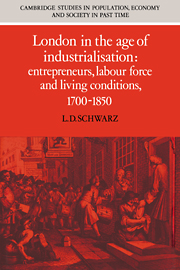Book contents
- Frontmatter
- Contents
- List of figures
- List of tables
- Acknowledgements
- List of abbreviations
- Introduction
- Part I Wealth and occupations in London
- Part II Fluctuations and mortality in the metropolis
- Part III The standard of living and the London trades
- 6 The making of a wage rate
- 7 The challenge of sweated labour: a tale of four trades
- 8 The defences of the inferior artisans
- Conclusion: downstream from industrialisation
- Appendices
- Bibliography
- Index
- Cambridge Studies in Population, Economy and Society in Past Time
8 - The defences of the inferior artisans
Published online by Cambridge University Press: 11 September 2009
- Frontmatter
- Contents
- List of figures
- List of tables
- Acknowledgements
- List of abbreviations
- Introduction
- Part I Wealth and occupations in London
- Part II Fluctuations and mortality in the metropolis
- Part III The standard of living and the London trades
- 6 The making of a wage rate
- 7 The challenge of sweated labour: a tale of four trades
- 8 The defences of the inferior artisans
- Conclusion: downstream from industrialisation
- Appendices
- Bibliography
- Index
- Cambridge Studies in Population, Economy and Society in Past Time
Summary
The equilibrium that was referred to in the previous chapter could also be interpreted as meaning the maintenance of some autonomous areas for labour. There are of course always such areas, and, as frequently said, their survival depends on many factors – and these include suitable legal and political institutions. The eighteenth-century London artisan found himself with a range of institutions which had been created in an earlier age. He – it was only men to whom this applied – tried to use them to maintain his areas of autonomy and his standard of living. Improvements were desirable, but maintenance was essential. The artisans, and many of the smaller masters to whom they were so akin, were engaged in a ceaseless quest for stability. This meant the stability between contending forces, the temporary stability that could be wrested from the balance of economic forces and opportunities. From time to time the balance changed, and the position of the artisans changed with it. Always they were aware of the threat of the less skilled – which meant the threat of penury as well as of loss of status. As the nineteenth century would make clear, basic economic trends could not be opposed in the long run. But such trends could hardly be foreseen during the eighteenth century. The journeymen knew that from instability they would probably emerge the losers, but they also knew that the balance of stability needed to be constantly redefined. They used the institutions they inherited. None of these were ideal for maintaining stability – in a society as dynamic as that of eighteenth-century England this would hardly be expected – but some were of service.
- Type
- Chapter
- Information
- London in the Age of IndustrialisationEntrepreneurs, Labour Force and Living Conditions, 1700–1850, pp. 209 - 230Publisher: Cambridge University PressPrint publication year: 1992



